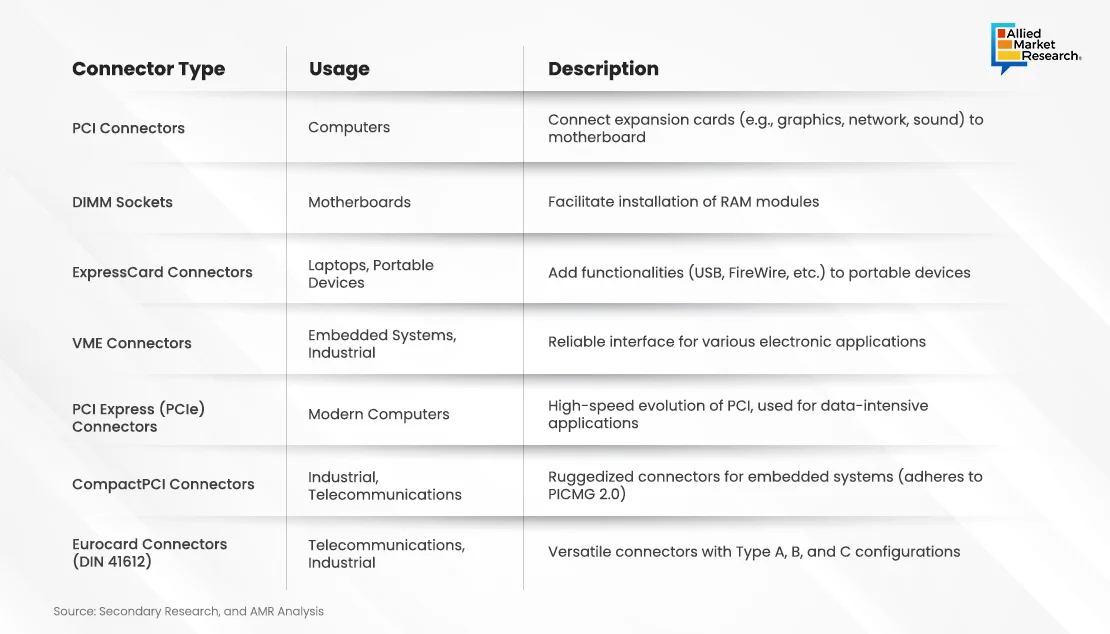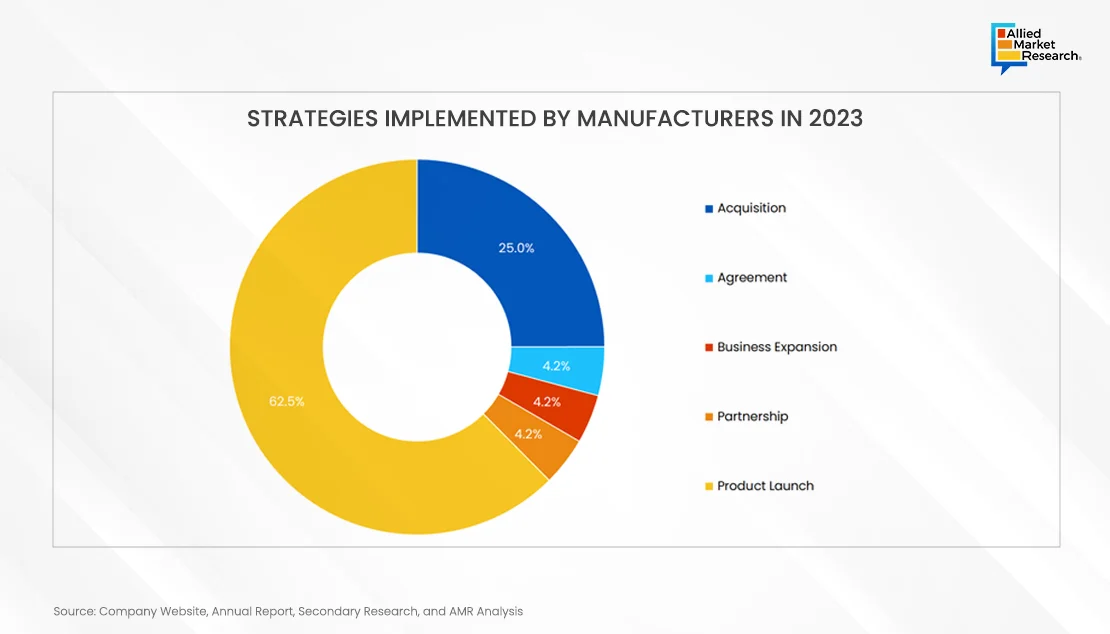Table Of Contents
- Types of Linear Card Edge Connectors
- Evolution of Linear Card Edge Connectors
- Increasing Acceptance of Linear Card Edge Connectors is Fueling Expansion of Market.
- Strategies Implemented by Manufacturers in 2023
- Emerging Applications: Transforming User’s Experiences with Personalization and Innovation
- Conclusion

Sonia Mutreja

Pooja Parvatkar
Linear Card Edge Connectors: The Backbone of Electronics

Linear card edge connectors are a fundamental component in electronic systems, serving as a crucial interface between printed circuit boards (PCBs) and other electronic components. Characterized by parallel rows of contacts or pins along one or more edges of a PCB, these connectors facilitate the transmission of signals, power, and data between interconnected modules within electronic devices. Their standardized design ensures compatibility and ease of integration across a wide range of applications.
Types of Linear Card Edge Connectors
Linear card edge connectors come in various types, each designed for specific applications and requirements. Some of the common types of connectors are as follows:
- PCI Connectors (Peripheral Component Interconnect)
- DIMM Sockets (Dual Inline Memory Module)
- ExpressCard Connectors
- VME Connectors (Versa Module Europa)
- PCI Express (PCIe) Connectors
- CompactPCI Connectors
- Eurocard Connectors (DIN 41612)
Linear card edge connectors play pivotal roles in ensuring the seamless integration and communication of electronic components within devices, contributing to the modularity and interoperability of modern electronics. The specific type chosen depends on the application's requirements, such as data transfer speeds, form factor, and environmental conditions. Below is the representation of standard card edge connectors and their use cases.

Evolution of Linear Card Edge Connectors
The evolution of linear card edge connectors has been marked by a commitment to standardization and compatibility. In their early stages, these connectors focused on establishing a standardized interface to ensure seamless integration among various electronic components and PCBs. This drive for standardization facilitated interoperability in electronic systems, enabling different devices to work cohesively.
Another significant phase in the evolution of linear card edge connectors involved miniaturization and compact design. As electronic devices became increasingly smaller and more portable, there was a rise in demand for connectors that could accommodate these space constraints. Linear card edge connectors adapted to this need, evolving into more compact designs without compromising on reliability. This evolution was particularly critical in meeting the demands for various industries such as consumer electronics, where smaller form factors are essential.
Furthermore, the ongoing evolution of linear card edge connectors has seen a heightened focus on performance enhancements. These connectors have adapted to support increased data rates, a crucial development in the era of data-intensive applications, high-speed computing, and multimedia. In addition, there has been diversification of their applications, extending beyond traditional uses to emerging fields such as edge computing, artificial intelligence, the Internet of Things, electric vehicles, and 5G infrastructure. The connectors' adaptability to diverse applications increases their versatility and their continued relevance as integral components in advanced electronic systems.

The linear card edge connectors market is expected for growth, driven by rise in demand for high-speed linear card edge connectors and surge in the automotive sector, particularly with rise of electric cars and smart technologies. Investments in defense and submarine cables further contribute to market growth. However, complex fault detection and error removal processes hamper market growth. Moreover, the rise in the number of data centers offers lucrative opportunities, reflecting the market's adaptability to evolving technological landscapes. Companies in the linear card edge connectors market are anticipated to navigate challenges efficiently to capitalize on the lucrative prospects emerging in data center infrastructure.
Increasing Acceptance of Linear Card Edge Connectors is Fueling Expansion of Market.
The growing adoption of linear card edge connectors is a significant driver behind the expansion of the linear card edge connectors market. These connectors play a crucial role in various electronic devices, including smartphones, tablets, wearables, and other portable gadgets.
Miniaturization and Space Efficiency
- As electronic devices become smaller and more compact, the demand for space-efficient connectors has surged.
- Consumers expect sleek, lightweight, and portable devices, thus, driving the need for compact connectors.
- Manufacturers are responding by developing innovative solutions, such as embedded card connectors and low-profile connectors.
- Embedded card connectors are integrated into the device’s circuit board, reducing the overall footprint and enhancing durability.
- Low-profile connectors have reduced height, allowing for slimmer device designs.
- These advancements cater to the demand for smaller and more aesthetically appealing electronic devices.
Faster Data Transfer Rates

- With advancement in technology, there is an increase in the need for faster data transfer rates in electronic devices.
- Applications such as high-resolution video streaming, augmented reality (AR), and virtual reality (VR) require seamless data transmission.
- Card connectors are transitioning toward supporting higher data rates, such as USB 3.2 and PCIe 4.0, which enable data speeds of up to 10 Gbps and 16 Gbps, respectively.
- Manufacturers invest in R&D to design connectors that effectively handle these higher data transfer rates, enhancing user experiences across various industries.
Security and Reliability:
- Compact linear card edge connectors are critical for secure data transmission.
- In applications like finance, healthcare, and government, maintaining reliable connectivity is essential.
- Manufacturers focus on designing connectors that ensure direct access with printed circuit boards, longer contact lifespan, and robust connectivity.
- These features contribute to the overall security and reliability of electronic devices.
Strategies Implemented by Manufacturers in 2023
A comprehensive analysis of the recent developments and growth curves of various companies have helped to understand the growth strategies along with their potential effect on the market. Acquisition, agreement, business expansion, partnership, and product launch are the strategies adopted by the manufacturers operating in the linear card edge connector market in 2023.
Emerging Applications: Transforming User’s Experiences with Personalization and Innovation
- Edge AI Devices: As edge computing and artificial intelligence (AI) gain prominence, there is a rise in use of linear card edge connectors in edge AI devices. These connectors facilitate the integration of AI processing units and accelerators on PCBs, enabling local processing of data at the edge of the network.
- IoT (Internet of Things) Devices: With the proliferation of IoT devices, linear card edge connectors are increasingly employed in the manufacturing of sensor nodes, edge gateways, and other IoT-related devices. These connectors support the communication and connectivity requirements of diverse sensors and devices within IoT ecosystems.
- Medical Devices: In the healthcare industry, linear card edge connectors are used in medical devices such as diagnostic equipment, patient monitoring systems, and medical imaging devices. The compact and reliable nature of these connectors makes them suitable for applications where space is a critical factor.
- Robotics and Automation: Linear card edge connectors play a crucial role in robotics and automation systems where precise and reliable connectivity is essential. They are used in control boards and communication modules within robotic systems, contributing to the efficient operation of automated processes.
- Electric Vehicles (EVs): The automotive industry, particularly electric vehicles, relies on linear card edge connectors for power distribution, battery management, and control systems. As the demand for electric vehicles continues to rise, the use of these connectors in EV applications is expected to grow.
- 5G Infrastructure: The deployment of 5G networks requires advanced communication and processing capabilities. Linear card edge connectors are used in the construction of equipment such as base stations and antennas, supporting the high-speed data transfer and low-latency requirements of 5G technology.
- Wearable Electronics: Wearable devices, including smartwatches, fitness trackers, and health monitoring devices, utilize linear card edge connectors for connecting various components on small PCBs. The compact size and reliable performance of these connectors make them suitable for wearable applications.
- Industrial IoT (IIoT): In industrial settings, linear card edge connectors contribute to the connectivity of devices within industrial IoT systems. They are used in control panels, PLCs (Programmable Logic Controllers), and other industrial equipment to ensure reliable communication and data transfer.
Conclusion
Linear card edge connectors stand at the forefront of modern electronics, offering a reliable and versatile solution for seamless connectivity. As technological advancements continue to shape various industries, these connectors find use in emerging applications such as edge AI devices, IoT, medical equipment, robotics, electric vehicles, 5G infrastructure, wearables, and industrial IoT. Their standardized design, compact form factor, and robust performance make them indispensable components in the evolving landscape of electronic devices. Linear card edge connectors facilitate the current demands for connectivity as well as position themselves as vital contributors to the ongoing innovation and integration of technology across diverse sectors. As the world transitions towards a more connected and technologically advanced future, these connectors play a pivotal role in ensuring the efficiency and reliability of electronic systems.

